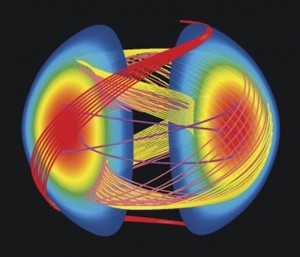
CMCs for power plant applications
(Science Network Western Australia) Scientists at the School of Materials Science and Technology, China University of Geosciences (Beijing) and the School of Mechanical and Chemical Engineering, The University of Western Australia (Perth) have developed iron-sialon ceramic matrix composite materials they say can drastically reduce the maintenance required for fluidized bed power plant applications. Most coal-fired plants in the two countries use circulating fluidized bed boilers and currently use alumina linings that are low-cost but require frequent maintenance, according to the workers. Produced by sintering ferro-silicon alloy and commercial-grade industrial alumina powders in a nitrogen atmosphere, the new material is expected to significantly reduce power plant maintenance schedules and downtime.
Novel technique coats glass with silver ions
(Azonano.com) Researchers at Yonsei University, Seoul, Republic of Korea, have developed a technique to coat glass with a layer of silver ions that can prevent growth of pathogenic bacteria including E. coli and salmonella. The team spin-coated glass with a silver-containing sol-gel at 200°C with a rotation rate of 2,000 rpm, used atomic force microscopy to characterize the resulting coating, and successfully tested its activity against various food-poisoning bacteria. The resulting coated glass has 90 percent of the transparency of uncoated glass, and its bending strength is actually slightly higher than uncoated material, the researchers said.
‘Nano-rust’ produces solar hydrogen
Water and some nanostructured iron oxide is all it takes to produce bubbles of solar hydrogen, according to scientists at Ecole Polytechnique Fédérale de Lausanne (Switzerland) and the Technion (Israel). The researchers built a photoelectrochemical cell that splits water molecules into hydrogen and oxygen in a single operation using only solar radiation, and accurately characterized the iron oxide nanostructures to be used in order to produce hydrogen at the lowest possible cost. “The whole point of our approach is to use an exceptionally abundant, stable and cheap material: rust,” says Scott C. Warren, primary author of an article appearing this week in Nature Materials. The workers produced a 10 ×10 cm prototype. They say its efficiency is in line with expectations, and the next step will be development of an industrial process to build the devices.
Can a guitar revitalize Spain’s Talavera ceramic industry?
(Reuters) A Spanish musician recently played a guitar fashioned from ceramic for the first time in public and said he hoped production of the instrument could boost the flagging pottery industry of his hometown. Singer and guitarist Luis Martin, who took a month to make the blue and yellow glazed instrument with the help of a guitar maker and a potter, patented its design. “Talavera ceramics are well-known, but like everything else it’s a tough time because things are bad in Spain with the crisis,” Martin says. “If this project takes off it could provide work for a lot of people.” Martin believes ceramic guitars may find a market among musicians much like the niche glass guitars have carved in the industry. “People would want to buy ours out of curiosity and for the sound it produces,” he says.
Graphene-chlorophyll phototransistor uses plant material to gather light
(Decodedscience.com) Researchers from Academia Sinica of Taiwan and the National Taiwan University have developed a hybrid graphene/chlorophyll material with potential for use as a phototransistor. The chlorophyll acts as an efficient photoabsorber, converting light from the sun into electrons; the graphene transports the electrons. Fabrication of the device was kept simple by placing a drop of chlorophyll solution atop the graphene layer and leaving it to evaporate. The technique provided uniform coverage, good contact between the two materials, and could facilitate process scale-up, the researchers say. The chlorophyll-graphene transistor showed efficiency comparable to other systems such as graphene/quantum dot devices, they add.

